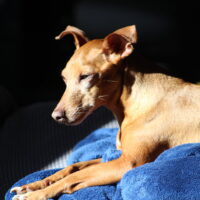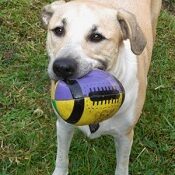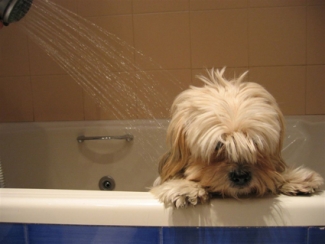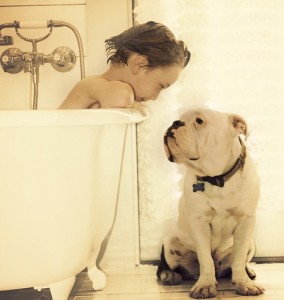Bathing Your Dog
Trying to decide when and how to bathe your dog is often difficult, because bathing frequency depends on a number of factors: the particular breed of dog, how much time is spent outdoors, the dog’s age, and any existing medical conditions, to name a few.
When and how you bathe your dog will change throughout the year and throughout the dog’s life. Here are some reasons that your dog may need a bath, as well as some bathing pointers:
The dog rolled in something and smells. Pretty obvious right? This is actually the #1 reason most dogs are bathed. If your dog has a habit of seeking out something smelly and rolling in it, then he will need a bath right away. Use Shampoochie® Herbal Dog Shampoo Soap and don’t be afraid to wash him twice. The dog has a doggy smell. An odor on the coat can often be traced to a problem with the ears, mouth, feet, or anal glands. An odor coming from the skin is often a sign of disease, such as a yeast infection. Any dog with more than a “doggy” smell should be checked by a veterinarian. For dogs with a simple doggy odor, Shampoochie® Dog Shampoo Soap is a perfect choice. The dog has dandruff. Dandruff may be caused by dry, irritated, or oily skin, but all of these conditions can be helped by all natural, vegan, Shampoochie® Herbal Dog Shampoo Soap and a good bathing. The dog has allergies. Bathing your dog with Shampoochie® Herbal Dog Shampoo Soap can be soothing and help reduce itching.A few other tips to remember about bathing. . .
Always use a shampoo formulated for dogs. Human shampoos have a different pH level and often use harsher detergents than pet shampoos. You can do more damage than good if you use a human shampoo on pets. After shampooing, rinse very thoroughly.
Start bathing your dog when he or she is young so bath time will be easier as your dog ages.
Brushing is one of the best ways to take care of your dog’s skin and coat and, in many cases, is more important than bathing. Brushing and removing mats should always be done before the bath.
Your pet’s good diet will help maintain a healthy haircoat and skin. For the best coats, we recommend daily brushing.
Every dog needs a bath from time to time so follow your instincts – and these tips – and your dog and your family will thank you for it.
Tips
Dirt and odors love dogs, which makes learning how to give a dog a bath an essential part of caring for your pet. You may have visions, or past experiences, of your dog tearing through the house half-soaped up and shaking water all over your new furniture. But bath time doesn’t have to be an occasion to dread if you plan ahead and give your dog a bath he’ll enjoy.
How often to bathe a dog?
How often you’ll have to bath your dog depends on a number of factors such as his breed, type of coat, and what sort of mischief he’s been into. A dog involved in water sports or that likes to dig in the yard will need to be bathed regularly, while a short-haired couch potato can go for a few months between baths.
You shouldn’t have to ready a dog bath more than once a month and more likely every two or three months. Bathing your dog more than once a month could damage his coat and skin by removing their natural oils. The best guideline is to use the sniff test. When the doggy odor is too strong, it’s dog bath time. Consult your veterinarian for specific guidelines when necessary.
In warm months, bathing the dog outside means less mess and a shorter drying time. Set the nozzle to mist and let the water fall onto the dog’s body to help his body more easily acclimate to the cooler water temperature.
Introducing the bath tub
Before you have to give your dog a bath, you should introduce the bathing process in a few steps over the span of a week or so. This can ease your dog’s anxiety and make dog baths more enjoyable for both of you.
Step 1: In the tub without water – Put your dog in the tub once or twice a day. Give him a treat and lots of praise while he’s there. Don’t make a fuss over him when he climbs back out since you want to make being in the tub the fun part. Slowly increase the time your dog stays in the bath to get the treat.
Step 2: In the tub with an inch or two of water – Once your dog readily gets in the bath, add some lukewarm water before he climbs in. Reinforce with a treat and praise as before and slowly increase the time he has to stay before being rewarded.
Step 3: In the tub with running water – When Step 2 goes smoothly, try running the water and wet your dog with the shower head or pour some water over him from a plastic pitcher. You should be ready for hassle-free dog baths in no time.
More Tips
Gather your bath supplies – Collect all the supplies you’ll need to bath your dog before you start, and let him sniff everything to satisfy his curiosity. Essential dog bath items include:
Brush or comb: Choose the appropriate grooming brush or comb for your dog’s coat.
Shampoochie® Herbal Dog Shampoo Soap: Never give a dog a bath with products made for people. The pH balance isn’t appropriate for dogs and can damage their coat and skin.
Cotton balls: Inserted shallowly into each ear to keep water and soap out.
Plastic pitcher: If you don’t have a removable shower head, a plastic pitcher is perfect for wetting and rinsing your dog.
Drain screen: Keep your plumbing happy and free of dog hair.
Towels for drying
Attaching a hose to the bathtub or shower faucet may make it easier, too. Two optional items you might want when you give a dog a bath are special ophthalmic ointment to keep your dog’s eyes from being burned by the shampoo (available from your veterinarian or a pet supply store) and ear dry solution if your dog is susceptible to ear infections.
The steps for bathing a dog
Once you have everything gathered up, it’s time to give that dog a bath! Before you start, close the door to the bathroom or whatever room you’re bathing him in to thwart any escape attempts.
Step 1: Brush your dog – Always brush your dog before giving him a bath to remove loose hair, tangles, and mats. Bathing will only make them worse.
Step 2: Add dog to bath tub – Have your dog climb into the tub. Put a cotton ball into each of his ears. Make sure you don’t press them down too far into the ear canal. Apply protective eye ointment to his eyes if you’re so inclined.
Step 3: Turn on the water and wet your dog – Use lukewarm water to wet your dog from front to back and underneath, making sure to monitor the water temperature. Try not to get her head wet yet. A dog with a dry head has less of a tendency to shake since the best shakes always start from the front and move back. You can also keep a firm hold of the hair on her neck or her muzzle during the bath to prevent shaking.
Step 4: Shampoo – Start at the neck and move back to the tail in the direction of hair growth. Don’t forget the belly, armpits, groin, and between the toes. If your dog has a long coat, squeeze and press the shampoo through his hair rather than rubbing it, which can cause tangles.
Step 5: Rinse and repeat if necessary – Rinse out the soap completely. Run your hands over your dog and check for any slimy or slippery spots. You’ll need to re-rinse those places. Soap left on your dog after you give him a bath can cause skin irritation so be thorough when rinsing. If your dog is particularly dirty and smelly, you can reapply soap to the offending areas, wash, and rinse again.
Step 6: Wash the face last – Wet your dog’s head carefully and use your fingers or a wash cloth to soap up his skull, muzzle, and ears. Keep soap away from his eyes. Then rinse everything again from front to back and do one last check for soapy residue that could need rinsing.
Step 7: Prepare for the shake and then dry thoroughly – Remove the cotton balls from your dog’s ears. Then hold up a towel and stand back to let your dog shake himself dry. If he just stands in place, you can blow in his ear to trigger a good shake. Use the towels to dry your dog as much as possible. If he has long hair, pat rather than rub him dry to avoid tangles.
After you give a dog a bath she may go nuts, so expect a sudden burst of crazy running and rolling. Keep her inside and out of drafts until she’s completely dry.









